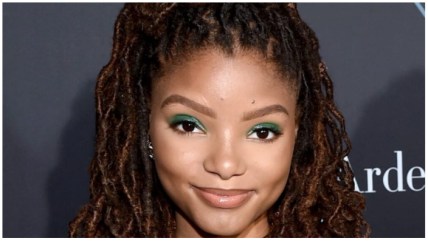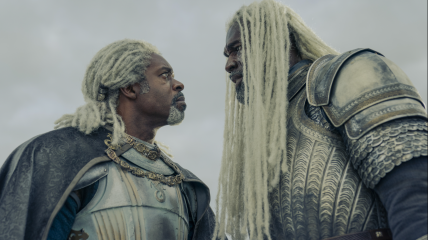Is Disney’s ‘The Little Mermaid’ trailer a modern-day doll test?
OPINION: Watching viral clips of young Black girls seeing themselves in Halle Bailey’s rendition of Ariel is more promising than what studies observed in the 1940s.

Editor’s note: The following article is an op-ed, and the views expressed are the author’s own. Read more opinions on theGrio.
Representation may not solve everything, but it sure does matter.
When I think about the early years of my childhood, the two things that defined those years were the Mighty Morphin Power Rangers and WWF (now WWE) wrestling. My brother and I were obsessed with these two action-packed enterprises that often veered into elaborate spectacle, costumes and thrills. And while these aspects were what drew us to initially becoming fans, what kept us was being able to see ourselves in the Black characters portrayed.
Growing up, the Black Power Ranger was literally Black with actor Walter Emanuel Jones transforming into a superhero who could do backflips, kick butt and arguably play the coolest character on a series that often lacked melanin elsewhere. WWF had Black wrestlers such as Dwayne “The Rock” Johnson, Mark Henry and Booker T. Seeing them win championship belts and defeat their white counterparts in the most assured (and often cocky) demeanor gave us a level of confidence in ourselves that was unmatched. Overall, these experiences reassured us that there was a world in which Black men could win victoriously and defeat evil in a society that celebrated them.
Today, a new generation of Black girls are having a similar moment with Disney’s latest live-action remake of one of its animated classics. This time around, it’s The Little Mermaid starring a Black Ariel played by musical wonder Halle Bailey. All over social media, there are tons of videos of young Black girls from around the world reacting positively to the new trailer of Bailey singing the iconic “Part of Your World” from the film.
“Her skin…it looks like mine,” one very observant girl said to her mother in a video.
“She’s Brown like me,” another girl said super excitedly.
Despite the representational breakthrough, not everyone seems to be getting with the times. There also has been widespread backlash (from mostly white) fans of the original 1989 classic who can’t help but act like mermaid police and argue that Ariel should remain caucasian. Every form of critique you can think of—from arguing that Bailey’s hair in the trailer wasn’t red enough to even complaining about how her soulful vocals weren’t similar to Broadway actress Jodi Benson (who voiced the original animated character) were—the hate (read: white supremacy) was real.
Newsflash: Mermaids aren’t real and white people aren’t the only ones who exist in fantasy.
White people trying to control not only planet Earth but imaginary worlds have been a trend lately. Similar controversies have also arisen as Black performers have been given roles in traditionally all-white casts in the new spinoffs of Game of Thrones and The Lord of the Rings. From not wanting Black hobbits to decrying seeing Black royalty, white people seem to believe in fire-breathing dragons, wizardry and witchcraft more than diversity itself.
The good news is that while they might have a problem imagining us, the youth are seeing (and saying) otherwise.
In the 1940s, Kenneth and Mamie Clark, a married Black psychological research couple, conducted a groundbreaking study on how Black children viewed their racial identity. Known as “The Doll Test,” the pair tested how Black kids reacted when given the choice to play with both Black dolls and white dolls. Sadly, they often preferred the white dolls and attributed positive values to them in comparison to speaking negatively about the Black dolls. Even worse, many of them grew upset with having to identify with the Black doll they had spoken ill about.
The conclusion drawn from this study was that “color in a racist society was a very disturbing and traumatic component of an individual’s sense of his own self-esteem and worth.” Looking at where Black Americans were at the time—no Civil Rights Act, Jim Crow laws in effect and segregation tolerated (NAACP lawyers arguing against school segregation in the landmark Brown v. Board of Education case used the Clarks’ doll test to make their case)—it should come as no surprise that Black children suffered from low self-esteem. Black people were living in a world where it was legal to treat them as second-class citizens.
Eighty years later, it appears things have changed for the better. Many young Black girls are seeing a trailer of a once-beloved white character and loving her anew with skin as dark as theirs. While many white adults are complaining about the skin color of a character that is over 30 years old, Black youth are embracing the evolution of Disney’s once all-lily-white princess syndrome. That’s a pretty big damn deal considering how hard it’s still been for the animation studio to give us consistently Black characters overall.
For example, outside of Bailey’s Ariel, Disney has only had one Black princess—Tiana in the 2009 hit, The Princess and the Frog. We won’t even get started on how we were shortchanged by the House of Mouse when it transformed her into a frog for most of the film. To be honest, with this rendition of The Little Mermaid, we’re finally getting a Black Disney Princess on screen with multiple singing numbers and acting sequences—in the flesh.
If young Black children in the 1940s could easily prioritize whiteness over their own identity, then the power of such imagery speaks more to the psychology of how we ultimately treat others and love ourselves. It’s 2022, and Black girls are finally getting a chance to see a live-action Disney princess that looks like them. The dolls, theme-park performances, T-shirts and other accompanying merchandise inspired by this remake will further represent a campaign that’s not just about Disney capitalizing off its franchise but prioritizing the imagery of a beautiful Black princess for all the world to see.
Again, representation won’t solve everything—but there’s no denying how much it matters right now for a generation of children who are more than ready to embrace a new Ariel and hopefully more images of Blackness.

Ernest Owens is the Editor at Large of Philadelphia magazine and CEO of Ernest Media Empire, LLC. The award-winning journalist has written for The New York Times, NBC News, USA Today and several other major publications. Follow him on Facebook, Twitter, or Instagram and ernestowens.com.
TheGrio is FREE on your TV via Apple TV, Amazon Fire, Roku, and Android TV. Please download theGrio mobile apps today!
More About:Entertainment











